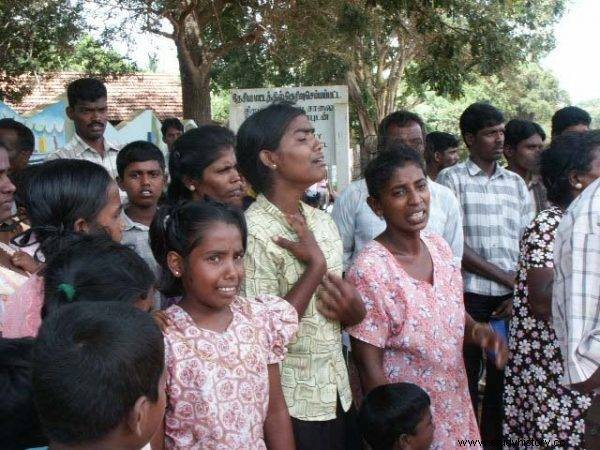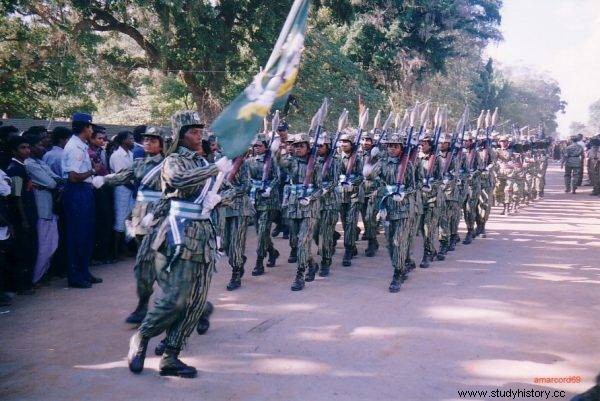During the Ceylon Civil War, the Tamil Tigers, a terrorist organization recruiting even teenage girls, faced government forces.
The civil war in Ceylon (today's Sri Lanka) lasted over 20 years and is described as a severe defeat for the United Nations. The most beautiful beaches on the island hide thousands of bodies of victims of the conflict under the sand. On one side were the Tamil Tigers - a brutal terrorist organization that even recruited teenagers. Secondly, a government that has committed numerous war crimes, including genocide.
Tamil pogroms
Even before open warfare, the situation in Ceylon was literally hanging in the balance. Conflicts between the two largest ethnic groups - Sinhalese and Tamils - began shortly after the former British colony gained independence. Everything separated them. The first were concentrated in the south of the country, the second in the north. Their languages were based on different alphabets and were so different from each other that communication without a translator was almost impossible. The dominant religion among Sinhalese was Buddhism, among Tamils - Hinduism, less often Christianity and Islam.

Between 1953 and 1983 the Tamils fell victim to six pogroms
The Sinhalese majority quickly gained the upper hand in the government and soon dominated it completely. This was connected with the gradual limitation of the rights of Tamils - their language was not in force in the offices. Prime Minister Solomon Bandaranaike, as well as Sirimavo Bandaranaike, who succeeded him, strove to fully nationalize the country . Even church schools were nationalized. With time, the persecution began to grow stronger and stronger . Between 1953 and 1983, the Tamils fell victim to six pogroms that were permitted by the authorities at the time.
The last of them, the so-called "Black July", could have cost the lives of up to 3,000 people . In Colombo, the then capital of the country, crowds incited by politicians and state services killed the minority living in the city. Monks also called for violence. Sri Lanka is one of the few countries in the world where Buddhism has taken on a bloody, brutal form. In 1976 the Tamils established an armed organization and Black July began an open war with the government.
The Liberation Tigers of Tamil Eelam
Despite the significant disproportion between government forces and the Tigers , the organization made an armed attempt to create an independent state of Ilam . Some of the areas that the new country would cover were actually conquered. In fact, they functioned as a separate country. The lands conquered by the Tamil Tigers had their own government, army, courts, and an education system. Soon, the radio station Voice of the Tigers and the Tamil Eelam National Television started broadcasting there.

It is estimated that there were 8,000 to 10,000 well-armed soldiers.
It is not known how many people belonged to the Tigers. It is estimated that there were 8,000-10,000 well-armed soldiers. Who financed them? The organization was supported by Tamil minorities from other countries, scattered throughout Asia, North America and Europe. In addition, in the mid-1980s, more and more signals of the group's smuggling activities began to appear. Soon it was officially declared terrorist and some of its members arrested.
This had dramatic consequences. After a wave of detentions in the ranks of the Tigers, there were no more soldiers. The organization therefore recruited women who were getting younger and younger with time . It was by no means a voluntary recruitment. In the final stages of the conflict the army was "almost half of teenagers . Children were kidnapped from homes and public places, there were beatings and arson. Vetrichelvi, training and indoctrinating recruits, became a Tigress at the age of 17. However, Amnesty International even mentioned fourteen-year-olds.
Initially, women and adolescents were mainly paramedics. With time, they were already supporting all divisions. Even the infantry and the Black Tigers group responsible for the suicide bombings.
End of the war
The first decade of the 21st century ended the armed conflict that lasted 26 years. After the United Nations withdrew from the island, the Sri Lankan army launched an offensive against the terrorist organization. The government cut off the separatist aspirations of the Tigers with regular military actions. Thousands of civilians were killed in the battles for more cities, and the defense of the Tamils became more and more desperate. The most recent actions in 2009 were mainly suicide bombings.
The Liberation Tigers of Tamil Eelam laid down their arms on May 17, 2009, and the conflict was declared over a day later. The war claimed a total of around 90,000 lives. Mahinda Rajapaks, backed by the Sinhalese, won the presidential election. His competitor, Sarath Fonseka, was soon accused by the government of divulging classified military information.

Girls who became terrorists. They made up almost half of the Tamil army
However, this did not end the tragedy in Ceylon. In 2011, the United Nations issued a report accusing the Sri Lankan government of crimes against humanity. According to the document, the army shot prisoners and raped women, deliberately shelled and blown up hospitals and UN and Red Cross buildings. As a result, the military was to kill up to 40,000 civilians. The country's authorities dismissed the report as biased and false.
Less than two months later, other tragic reports appeared. According to the recordings published at that time, the Sri Lankan army carried out rape and mass executions of captured Tamils. The photos showed the bodies of civilians (including children) on the beaches. These materials, in keeping with President Rajapaks, were fabricated to denigrate the government. Sarath Fonseka was imprisoned for three years for finding that the murder of the surrendered Tamils was an official order.
Sources:
- Scars (2020), dir. Zwiefka A.
- Harrison F., Tamil Tigers appeal over shrine [in:] news.bbc.co.uk [access:November 26, 2021].
- Manogaran C., The untold story of the ancient Tamils of Sri Lanka , Chennai 2000.
- McConnell D., The Tamil people's right to self-determination [in:] "Cambridge Review of International Affairs" 21 (1).
- Sri Lanka:Tamil Tigers raid families to recruit child soldiers [in:] amnesty.org.pl [access:November 26, 2021].
